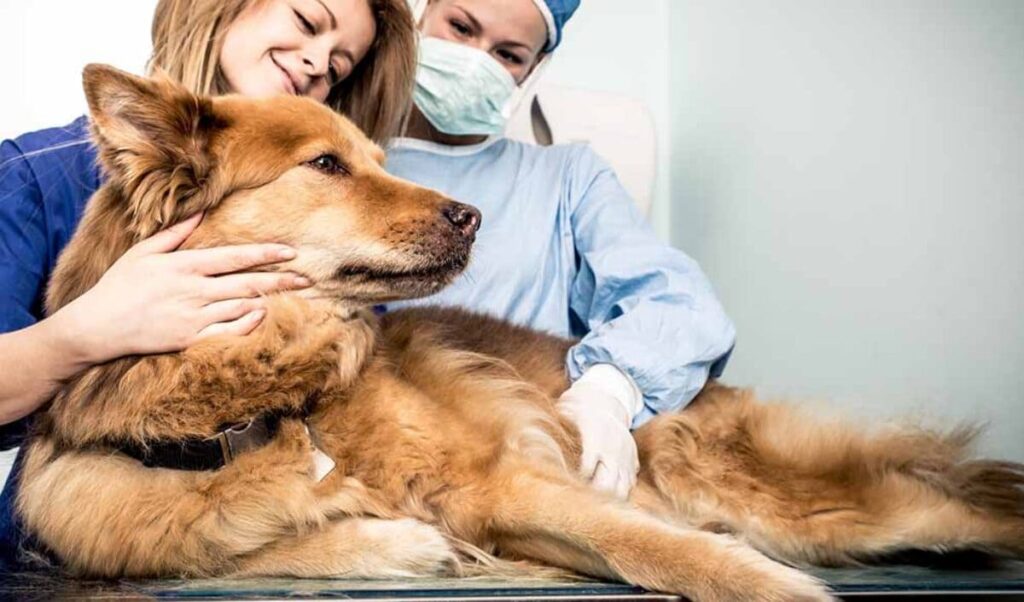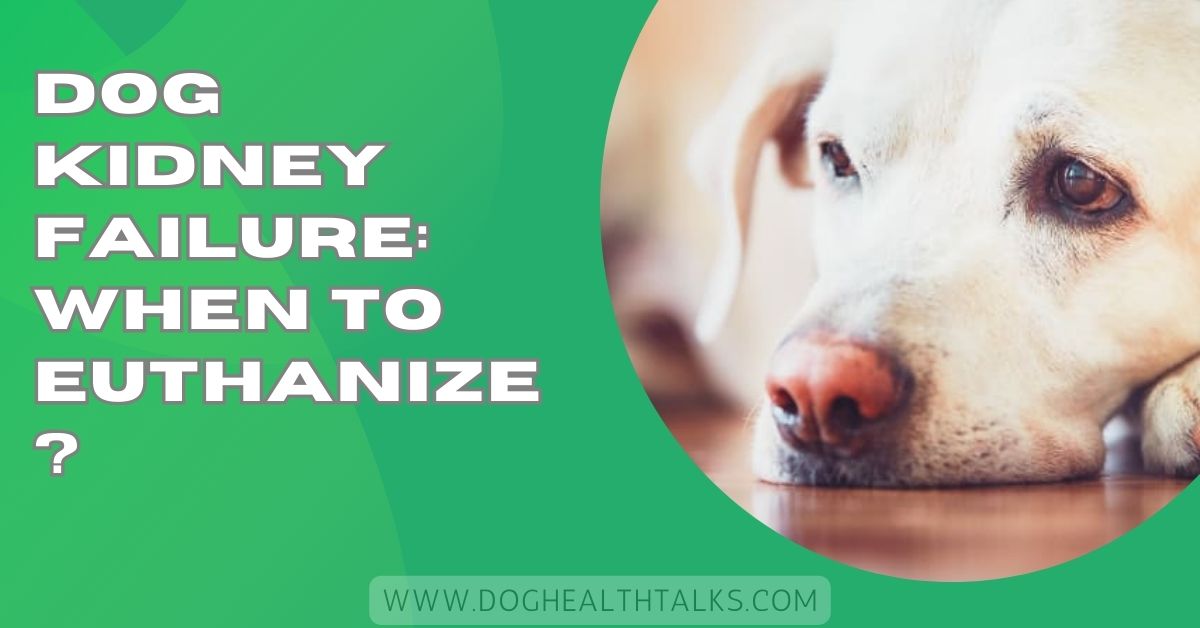Learning your dog has kidney failure is heartbreaking. You may wonder how long they have, what treatments can help, and how to know when it’s time to let go.
Euthanasia for dogs with kidney failure is considered when pain, loss of appetite, weakness, and poor quality of life outweigh treatment benefits. Always consult your vet for compassionate, safe, and timely guidance.
This guide explains the disease in simple terms, offers practical care tips, and gently walks you through the most complex decision—when to consider euthanasia—with love, clarity, and compassion.
The Kidneys—What Do They Do?
The kidneys are small but powerful organs that keep your dog’s body balanced and healthy. They filter waste from the blood, remove toxins through urine, regulate water, control blood pressure, and even help make red blood cells.
When kidneys stop working properly, toxins build up in the body. This causes many of the symptoms we see in kidney disease.
Healthy kidneys are essential for life, and even partial loss of function can create serious health issues for your beloved dog.
An Overview Of Kidney Disease In Dogs

Kidney disease in dogs can develop suddenly (acute) or slowly over time (chronic). Acute kidney failure often comes on quickly, sometimes due to toxins, infections, or dehydration.
Chronic kidney disease develops gradually, especially in older dogs, and may go unnoticed until the kidneys are badly damaged.
In both cases, the kidneys lose their ability to filter waste. This buildup makes dogs feel sick, weak, and tired. While treatment can slow progression, kidney failure is a serious and often life-limiting condition.
Symptoms Of Kidney Disease
Kidney disease symptoms often start mild and grow worse with time. Early signs include drinking more water, urinating more often, and slight weight loss.
As the condition progresses, dogs may show poor appetite, vomiting, diarrhea, pale gums, drooling, bad breath, and general weakness.
Some dogs also become lethargic, seem confused, or lose interest in daily life. Because these symptoms overlap with other illnesses, seeing your vet is essential. Blood tests and urine tests confirm the diagnosis and stage of the disease.
Treatment For Acute Kidney Disease
Emergency veterinary care is often needed when a dog suddenly develops acute kidney failure. Hospitalization with IV fluids helps flush toxins from the body and restore balance.
The vet may also give medications to control nausea, regulate blood pressure, or stimulate appetite.
With quick treatment, some dogs recover kidney function, though not always entirely. Others may transition into chronic kidney disease.
The outcome depends on the underlying cause and how early treatment begins, which is why urgent vet care is vital.
Treatment For Chronic Kidney Disease

Chronic kidney disease is usually managed rather than cured. Vets often follow international guidelines (IRIS staging) to decide the best treatment.
This may include a kidney-friendly prescription diet, daily or weekly fluids under the skin, blood pressure medications, anti-nausea drugs, and supplements for phosphorus or potassium balance.
Regular check-ups and blood tests are needed to track progress. Many dogs can live comfortably for months or even years with good care. The goal is to slow disease progression while maintaining quality of life.
At-Home Methods For Improving Quality Of Life
1. Reduce The Stress Of Increased Urination
Dogs with kidney disease may urinate more often, sometimes leading to accidents. To help, you can use potty pads, dog diapers, or waterproof bedding.
Keeping your dog clean and dry prevents stress and discomfort. Simple adjustments like these make daily life easier for you and your pet while preserving your dog’s dignity.
2. Find Appealing Foods
Appetite often decreases with kidney disease. Offering a variety of kidney-safe foods, including dry and canned options, may encourage eating.
Adding low-sodium broth or small amounts of baby food can tempt picky eaters. Work with your vet to ensure all food choices are safe. The goal is not perfection but helping your dog maintain weight, energy, and comfort.
3. Soothe Your Dog’s Sore Mouth
Toxins from kidney disease can cause painful mouth sores. These sores make eating difficult. Gentle remedies like rinsing with cooled green tea or vet-prescribed “magic mouthwash” can help soothe discomfort.
Always check with your vet first. Reducing pain makes meals more enjoyable and gives your dog a better chance of keeping strength during their illness.
Prognosis For Kidney Failure
The outlook for dogs with kidney disease varies. Some live for years with proper treatment, while others decline quickly despite best efforts.
Factors like age, stage of the disease, and response to therapy all affect life expectancy. Improvement in appetite, energy, and lab results is a good sign.
However, when treatments no longer help and the quality of life declines, the prognosis becomes poor. While it is hard to hear, knowing the likely outcome helps families prepare for the difficult decisions.
Changes During The Last Days Of A Dog With Kidney Failure
1. Lethargy
Your dog may always seem tired, sleeping more and losing interest in walks or play. This profound fatigue happens because toxins build up when the kidneys stop working. Gentle comfort and a quiet space help them feel safe.
2. Decreased Appetite
Dogs in late kidney failure often refuse food or eat only tiny amounts. Their body struggles to handle waste, which makes eating unpleasant.
Offering soft, tempting foods may help, but loss of appetite usually signals that the disease is progressing.
3. Behavior Changes
You might notice your dog becoming restless, confused, or distant. Kidney failure affects the brain and emotions as toxins rise.
These changes aren’t your dog’s fault—gentle reassurance, patience, and comfort are the best ways to support them now.
Take Care Of Yourself, Too

Caring for a dog with kidney failure is emotionally draining. The ups and downs—good days followed by bad—take a toll on families.
Remember, your well-being matters too. Caretaker fatigue is real, and it’s okay to ask for help.
Lean on supportive friends, talk to your vet openly, and seek grief counseling if needed. Taking care of yourself ensures you can make clear, compassionate decisions for your beloved dog when the time comes.
1. Resources To Help You On This Journey
- Veterinarian guidance for medical advice and quality-of-life scoring tools.
- Pet loss support groups online and in local communities.
- Counseling or therapy for anticipatory grief.
- Trusted pet health websites like the American Kennel Club (AKC) and PetMD for reliable information.
The Final Days Of Kidney Failure In Dogs
1. Your Dog Is Always Tired
Extreme tiredness is common because the kidneys can’t clear toxins, making your dog weak and drained. They may sleep most of the day and avoid activity. Providing a soft, quiet resting place helps them feel safe and supported.
2. Loss Of Appetite Or Refusal To Eat
When kidneys fail, food becomes unappealing, and dogs often stop eating. This isn’t stubbornness—it’s the illness.
Offering soft, warm, or favorite foods may help, but refusing meals usually signals the disease is reaching its final stage.
3. Ongoing Nausea Or Digestive Upset
Nausea, vomiting, or diarrhea happen because waste builds up in the bloodstream. This discomfort makes eating difficult.
Gentle vet-approved medications and small, bland meals may ease symptoms, but ongoing sickness often means your dog’s body is nearing the end.
4. Pale Gums And Unusual Breath Odor
Kidney failure reduces red blood cells, causing pale gums and anemia. At the same time, toxins can create a metallic or ammonia-like breath odor. These signs indicate advanced disease and show your dog needs comfort-focused care.
5. Difficulty Standing Or Walking
Weak muscles and low energy make standing or walking hard. Some dogs collapse or stumble often.
Soft bedding, supportive harnesses, and keeping essentials close help avoid stress. This stage shows that your dog’s body is too weak to recover.
6. Loss Of Bladder Control
As the kidneys stop filtering, your dog may urinate more often or lose control entirely. Accidents aren’t intentional—they’re part of the illness.
During this difficult time, keep your dog clean, use absorbent pads, and focus on comfort, not discipline.
Making The Decision To Euthanize Your Dog With Kidney Failure
There is no single “right day” for euthanasia, but there is usually a window of time when it becomes a kind and compassionate choice.
If treatments no longer work, your dog is constantly uncomfortable, and joy in daily life has faded, it may be time to let go.
Work closely with your vet—they can guide you with medical insight and compassion. Remember, choosing euthanasia is an act of love, not giving up.
What Your Dog Wants You To Know About Saying Goodbye

Dogs live in the moment and feel our love deeply. They don’t measure time like we do, but know your heart.
Many would likely say it’s okay to let them go before every last bit of joy is gone if they could speak.
Your dog trusts you completely and knows your decision comes from love, not weakness. Saying goodbye is one of the hardest gifts we give them and one of the most compassionate.
How Kidney Failure Changes Your Dog’s Daily Life
As kidney disease progresses, even everyday routines become difficult. Drinking more, peeing often, feeling tired, and refusing meals can affect every part of the day.
Walks may shorten, playtime may fade, and your dog may prefer resting over everything else. These changes remind us that their body is struggling.
By noticing these daily shifts, you can better judge when your dog’s quality of life is slipping and when comfort should become the priority.
How To Assess Your Dog’s Quality Of Life
One trusted method is the HHHHHMM Quality of Life Scale (Hurt, Hunger, Hydration, Hygiene, Happiness, Mobility, and More Good Days Than Bad).
Each area is scored from 0–10, with higher totals showing better quality of life. If several regions score low consistently, it may be time to consider euthanasia.
This tool takes some guesswork out and gives you and your vet a structured, compassionate way to evaluate your dog’s comfort.
Senior Dog Kidney Failure: When To Euthanize
For senior dogs, euthanasia is considered when pain, nausea, or weakness outweighs joy in daily life. It may be the kindest and most compassionate decision if your dog refuses food, struggles to walk, or seems constantly uncomfortable.
Can A Dog Die Naturally From Kidney Failure
Yes, dogs can die naturally from kidney failure. However, the process is often painful due to nausea, weakness, and toxin buildup.
Many pet parents choose euthanasia instead to avoid prolonged suffering and allow a peaceful, dignified goodbye.
Last Days Of Dog With Kidney Failure Symptoms
In the final days, dogs often show extreme tiredness, refusal to eat, vomiting, pale gums, unusual breath odor, and loss of bladder control.
These signs reflect advanced organ shutdown, showing your dog needs comfort-focused care and gentle support.
Last Days Of Dog With Kidney Failure Treatment

Treatment in the last days is focused on comfort, not cure. Vets may suggest fluids, anti-nausea medication, or pain relief.
Soft bedding, hydration support, and calm companionship help ease suffering and provide peace during their final moments at home.
Dog Kidney Failure Weak Legs
Weak legs are common because kidney failure causes muscle loss, dehydration, and toxin buildup. Your dog may stumble, collapse, or struggle to stand.
Supportive harnesses, slip-free flooring, and close supervision can help keep them safe and reduce stress.
Last Days Of Dog With Kidney Failure Vomiting
Frequent vomiting happens when toxins build up and upset the stomach. Medication may reduce nausea, but it often signals late-stage disease.
Offering bland, small meals and plenty of comfort can help, though the focus should be reducing suffering.
Old Dog Kidney Failure: When To Euthanize
For older dogs, euthanasia is considered when treatments no longer help and daily life becomes filled with pain, weakness, or refusal to eat.
The goal is to protect your dog from unnecessary suffering and offer a gentle, peaceful farewell.
Older Dog Kidney Failure: When To Euthanize
If your older dog seems constantly tired, loses appetite, vomits often, or struggles to walk, it may be time to discuss euthanasia. This step is never easy but ensures love, dignity, and freedom from ongoing pain.
FAQs
1. Can Meloxicam Cause Kidney Failure In Dogs?
Yes, long-term or high meloxicam use can harm the kidneys. Always follow safe vet instructions and avoid giving without professional guidance.
2. How Do I Keep My Dog Comfortable With Kidney Failure?
Keep your dog comfortable with hydration, soft bedding, bland food, vet-approved medicine, and calm care. Comfort and peace are most important.
3. How Long Can A Senior Dog Live With Kidney Disease?
With proper treatment, senior dogs may live months to years. Lifespan depends on stage, care, and overall health condition management.
4. What Are The Signs Of the Final Stages Of Kidney Failure In Dogs?
Final stage signs include tiredness, refusing food, vomiting, pale gums, weak legs, and unusual breath odor, showing advanced disease progression.
5. What Drugs Cause Kidney Failure In Dogs?
Some drugs like NSAIDs, certain antibiotics, chemotherapy agents, and antifreeze toxins can damage the kidneys. Always ask your vet before giving.
Conclusion
Facing kidney failure in your dog is heartbreaking, and deciding when to euthanize is never simple. What matters most is your dog’s comfort and dignity. Work closely with your vet, trust your heart, and remember—choosing a peaceful goodbye is an act of love, not giving up.
Also Read:

